|
|
|
|
|
|
|
|
|
|
|
|
MONTEVERDI hai and high speed Series
1970: Peter Monteverdi's first rear-mid-engine sports car was the hai 450 SS
which made its debut at the 1970 Geneva Motor Show. The hai's exciting design
and not in the least its breathtaking performance established the MONTEVERDI
marque throughout the world practically overnight and it was regarded as one
of the most attractive sports cars of the 1970s.
|
|
|
|
|
|
|
|
1967: Frua-bodied MONTEVERDI high speed 375 S.
|
|
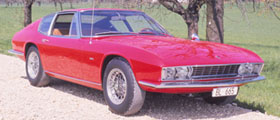 |
|
|
|
| 1967: Peter Monteverdi with the Frua-bodied MONTEVERDI high speed 375 S. |
|
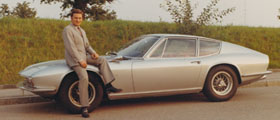
|
|
|
|
|
|
|
|
|
MONTEVERDI high speed 375 S
1967: the MONTEVERDI high speed 375 S was introduced at the 1967 Frankfurt Motor Show (IAA). The Swiss high-performance GT coupe was built up on a rectangular-beam space-frame chassis with a DeDion rear axle and powered by a 7.2-liter Chrysler engine.
The body, designed by Peter Monteverdi, was built by the Italian coachbuilding firm Frua and Peter Monteverdi's new creation immediately established itself in the top automotive luxury class.
|
|
|
|
|
|
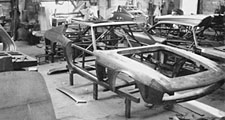
|
|
|
|
|
|
|
|
|
MONTEVERDI high speed 375 L bodied by Frua
1968: The 2+2 GT version, designated MONTEVERDI high speed 375 L, soon followed on the heels of the two-seat GT coupe. A longer wheelbase enabled four occupants to be comfortably seated and for its time it was exceptionally luxuriously outfitted, with suede-leather upholstery, automatic transmission, power steering and air conditioning.
|
|
|
|
|
|
1969: MONTEVERDI
2000 GTI. |
|
 |
|
|
|
| 1969: MONTEVERDI high speed 375 L with Fissore coachwork. |
|
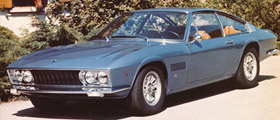 |
|
|
|
|
|
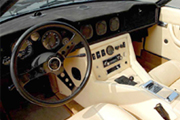 |
|
|
MONTEVERDI 2000 GTI
1968: Beside the 2+2 375 L a smaller prototype GT coupe, the MONTEVERDI 2000 GTI, was also built during 1968. Designed and created as a study project it employed BMW components and was powered by a four-cylinder, 130 DIN horsepower engine. In order to maintain the exclusivity of the high speed series, Peter Monteverdi decided not to build the lower priced, smaller GT coupe.
|
|
|
|
|
|
Fissore-bodied MONTEVERDI high speed 375 L
1968: Due to the rising demand for his cars Peter Monteverdi commissioned the Fissore brothers of Savigliano in 1968 as alternate partners for the coachwork manufacture. The first production model that resulted from the new collaboration was a 2+2 GT coupe, the MONTEVERDI high speed 375 L, which was introduced in 1969.
|
|
|
|
|
|
Peter Monteverdi had incorporated numerous detail modifications and improvements over the previous versions in this new construction, resulting in the uniquely timeless elegance characterizing the distinctive MONTEVERDI design elements to this day.
The 375 L was the most popular model of the high speed series and was constantly improved, upgraded and refined till the end of production in 1976.
|
|
|
|
|
|
| 1969: MONTEVERDI high speed 375 S with Fissore coachwork. |
|
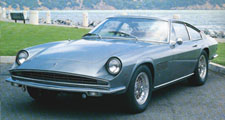 |
|
|
|
|
1970: MONTEVERDI hai 450 SS at the 1970 Geneva Motor Show.
|
|
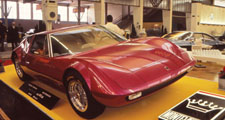 |
|
|
|
|
|
|
|
|
Fissore-bodied MONTEVERDI high speed 375 S
1969: That year saw the introduction of the second-generation MONTEVERDI 375 S two-seat GT coupe. Based on the 375 L but with shortened wheelbase, newly designed grille and front bodywork and, as a counterpoint to the larger 2+2 GT coupe, aimed at sports-oriented drivers, it was offered with a manual transmission option.
|
|
|
|
|
|
1970: Peter Monteverdi's presentation of the MONTEVERDI hai 450 SS at the 1970 Geneva Motor Show was like the proverbial bolt of lightening. Conceived as a two-seat, rear-mid-engine GT coupe, this super sportscar catapulted the MONTEVERDI marque into the world’s limelight practically overnight. Also see the link: MONTEVERDI hai.
|
|
|
|
|
|
| 1971: MONTEVERDI high speed 375/4 sedan with Fissore coachwork. |
|
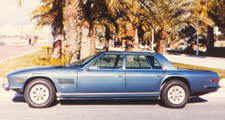 |
|
|
|
|
|
1971: Peter Monteverdi entered the market of exclusive luxury sedans no less successfully in 1971 with the MONTEVERDI high speed 375/4, competing against such well established top-line models as the Rolls-Royce Silver Shadow MK I and Mercedes-Benz 600. The MONTEVERDI high speed 375/4 sedan was based on the successful concept of the 375 L 2+2 coupe and was available with numerous amenities to order, comprising a partition between front and rear compartments as well as a built-in bar and TV set.
|
|
|
|
|
|
|
|
|
MONTEVERDI high speed 375/4
Luxury sedan custom-built to individual specification.
Rectangular-beam space-frame chassis.
DeDion rear axle.
Engine: 7206 cc Chrysler V8; 380 SAE bhp at 4600 rpm.
Top speed: 240 km/h.
|
|
|
|
|
|
|
|
|
|
|
|
|
|
|
|
|
|
|
|
|
|
|
|
|
|
|
|
1971: MONTEVERDI
high speed 375 C Convertible. |
|
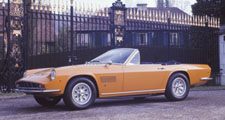 |
|
|
|
| 1972: MONTEVERDI Berlinetta. |
|
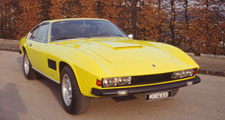 |
|
|
|
|
|
1971: The MONTEVERDI 375 C, the first convertible of the marque, was introduced in 1971. Based on the 375 S and due to its strong and stable chassis construction, the finely chiseled body lines which characterize all models of the high speed series were able to have been carried over to the new convertible.
|
|
|
|
|
|
1972: The MONTEVERDI Berlinetta GT coupe, powered by a 390 DIN bhp Chrysler 426 Hemi engine, made its debut in 1972. Possessing markedly sporty lines with a minimum of chrome, it effectively represented the trend of the times and also incorporated numerous modern active and passive safety features,
including a crash-resistant interior with a massive roll bar, progressively deforming bumpers, an automatic fire-extinguishing system, recessed instrumentation, a padded steering wheel hub and much more.
|
|
|
|
|
|
1973: MONTEVERDI hai
450 GTS. |
|
 |
|
|
|
|
|
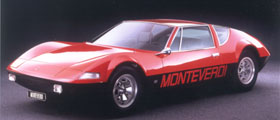 |
|
|
|
|
|
1973: The MONTEVERDI hai 450 GTS with a 5 cm longer wheelbase was introduced at the 1973 Geneva Motor Show by Peter Monteverdi and represented a modified and improved version of the hai 450 SS. Its Chrysler 426 Hemi V8 engine with aluminum cylinder heads provided the rear-mid-engine GT coupe with exhilarating performance and made a marked impression on the automotive press. Also see the link: MONTEVERDI hai.
|
|
|
|
|
|
|
|
|
|
|
|
|
1974: The MONTEVERDI Palm Beach convertible was based
on the two-seat,
high-performance Berlinetta GT coupe but with a Chrysler Magnum V8 power plant instead of the Berlinetta's 426 Hemi.
Engine data: 7206 cc, 305 DIN bhp
@ 4200 rpm, 240 km/h top speed.
|
|
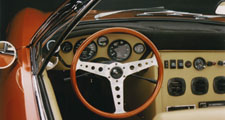
|
|
|
|
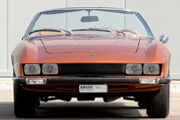 |
|
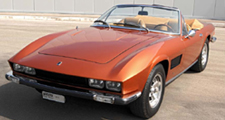 |
|
|
|
|
|
|
|
 |
 |
|
|
Oberwilerstrasse 20, 4102 Binningen/Basel, Switzerland
|
|
|
|